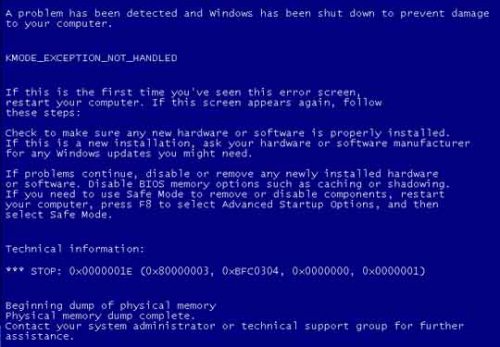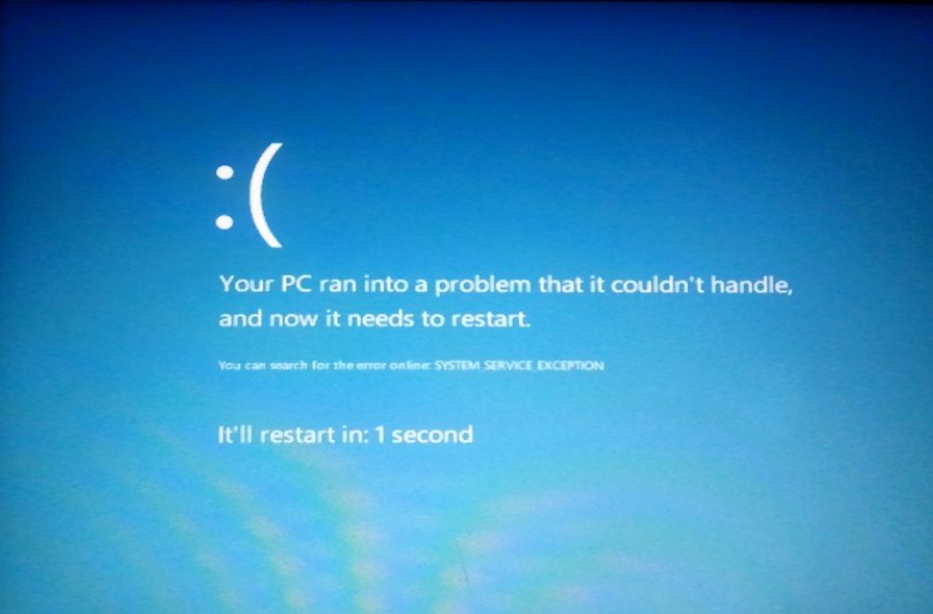| Vi bestrever å lokalisere nettsiden vår på så mange språk som mulig, men denne siden er for tiden oversatt med Google Translate. | Lukk |
-
-
produkter
-
ressurser
-
support
-
bedrift
-
Hva er en Blue Screen of Death?What is a Blue Screen of Death?
Av Steve Horton September 28, 2012Blue Screen of Death, bsod, windows12 CommentsBlå skjermen av døden
Den blå skjermen for døden, også kjent som en BSoD eller, offisielt, en STOP-kode, er en feilmelding som vises i Windows under en kritisk feil. Windows slutter å fungere, viser BSoD, og starter deretter på nytt. Noen ganger kan dette skje gjentatte ganger til du gjør noe med det. BSoDs ble først introdusert i Windows 1.0, men det var ikke før noen få versjoner senere at de begynte å ha nyttig informasjon, som folk kunne bruke til å prøve å løse problemet.
Frem til Windows 7 var BSoD ganske hard og uninviting, men fra Windows 8, inneholder den nå et stort frostig-ansikt-uttrykksikon og mindre teknisk sjargong. Dessverre introduserte Windows 8 også en hel rekke nye BSoDer som bare påvirker Windows 8-brukere. Det er der vi kommer inn!

Dette er en Blue Screen of Death i Windows 7.
Dette er en Blue Screen of Death i Windows 8.Feilmeldinger
Feilmeldingen som vises etter første setning i Blue Screen of Death er viktig. Skriv denne feilmeldingen ned, ta et bilde av det, gjør hva som trengs for å få denne feilmeldingen registrert. Deretter samsvarer det med følgende koblinger, som tar deg med til detaljerte veiledninger som gir løsninger for ditt spesielle maskinvare- eller programvareproblem. Hvis feilen din ikke er på denne listen, legg inn en kommentar, og vi vil skrive en veiledning for å fikse problemet!
UNEXPECTED_KERNEL_MODE_TRAP har å gjøre med maskinvarefeil eller konflikt.
NTFS_FILE_SYSTEM betyr at harddisken har mislyktes.
KMODE_EXCEPTION_NOT_HANDLED er et problem med harddisken.
IRQL_NOT_LESS_OR_EQUAL er et problem med en stasjon eller Windows-tjeneste.
PAGE_FAULT_IN_NONPAGED_AREA har å gjøre med ny maskinvare som er i konflikt med gamle drivere.
DATA_BUS_ERROR har å gjøre med dårlig minne på hovedkortet eller skjermkortet ditt.
INACCESSIBLE_BOOT_DEVICE betyr at harddiskens partisjon ikke lastes inn.
STATUS_SYSTEM_PROCESS_TERMINATED betyr at driverne trenger oppdatering.
DPC_WATCHDOG_VIOLATION har å gjøre med solid state-stasjonen din.
BAD_POOL_HEADER har å gjøre med inkompatible drivere eller applikasjoner.
WDF_VIOLATION vises når du synkroniserer en iPod til iTunes i Windows 8.
VIDEO_TDR_FAILURE har å gjøre med skjermdriveren på skjermkortet ditt.
HAL_INITIALIZATION_FAILED vises når du bruker Windows 8 i en virtuell maskin.
SYSTEM_SERVICE_EXCEPTION er et annet problem med utdaterte drivere.
CLOCK_WATCHDOG_TIMEOUT har å gjøre med CPUen din, spiller ikke fint med drivere.
SYSTEM_THREAD_EXCEPTION_NOT_HANDLED har å gjøre med utdaterte programmer eller en BIOS som trenger oppdatering.
BAD_POOL_CALLER , som mange BSoDs, er resultatet av dårlige drivere.
DRIVER_POWER_STATE_FAILURE betyr at BIOS-behovene er oppdatert til den nyeste versjonen.
VIDEO_SCHEDULER_INTERNAL_ERROR betyr at grafikkortdriverne må oppdateres.
WORKER_INVALID vises når et program, som AVG, ikke er fullt kompatibelt med Windows 8.
Sikkerhetsmodus
For å faktisk diagnostisere problemet, er omstart i sikker modus klok, da det vanligvis deaktiverer hva som helst maskinvare eller programvare forårsaker det, midlertidig. Deretter kan du ta skritt for å løse problemet permanent. Lykke til!
Driver Reviver
En god one-stop-shop som løser mange av de ovennevnte feilene, er Driver Reviver , et program som oppdaterer alle driverne på PCen din med en gang fra klarerte kilder. Sjekk det ut.
Was this post helpful?YesNoGratis Oppdatering av drivere
Oppdater driverne dine på mindre enn 2 minutter for å nyte bedre PC-ytelse - Gratis.
Gratis Oppdatering av drivere
Oppdater driverne dine på mindre enn 2 minutter for å nyte bedre
PC-ytelse - Gratis.
Fant du ikke svaret?Still et spørsmål til vårt fellesskap av eksperter fra hele verden og få svar i løpet av kort tid.most relevant siste artikler Fest det på Pinterest